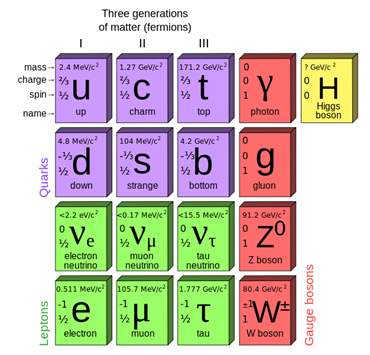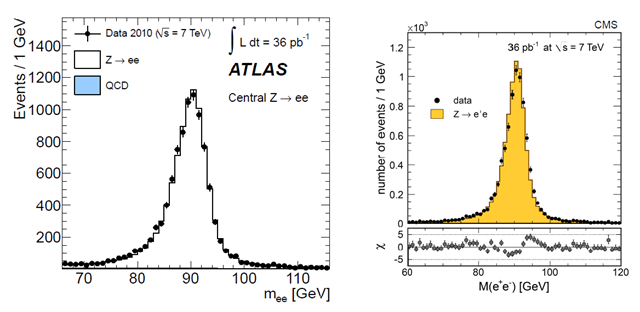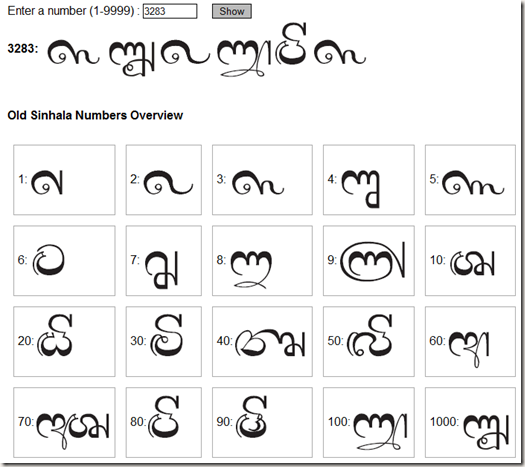Today (1st of June, 2013) marks the 30th anniversary of the announcement of the discovery of the Z boson at CERN. I did my BSc project on the production of Z bosons at the LHC, so I’ve been wanting to write about them for a while. So when I saw a post on the CERN’s facebook page yesterday morning about the anniversary, I knew I couldn’t put it off any longer. So here we go!
What’s a Z Boson?
Matter is made of particles, and the best theory we have for describing these particles and how they interact is the Standard Model. According to the standard model, quarks and leptons make up matter, the gauge bosons mediate interactions between particles and the Higgs boson gives mass to particles.
Particles in the Standard Model (Image from: Wikimedia Commons)
In physics, there are four fundamental interactions: strong, weak, electromagnetic and gravitational*. According to quantum field theories, there are particles responsible for mediating each of these types of interactions. Strong interaction between particles is mediated by the exchange of gluons. Exchange of photons mediates the electromagnetic interaction and gravitons are responsible for gravity (gravitons have not yet been observed, though!). The particles responsible for mediating the weak interaction are the W and Z bosons.
Weak Interactions with “Neutral Currents”
By the early 1960s, physicists already knew about weak interactions (for example, beta decay is a weak interaction) but they believed that all weak interactions were mediated by the W bosons, which have a charge of either +1 or -1. Because the W boson is charged, the interactions with their involvement are called “charged current” interactions. In 1968, Glashow, Weinberg and Salam came up with a theory that unified electromagnetic interactions with weak interactions. According to this theory, however, there had to be another uncharged boson that was also a carrier for the weak force. Unfortunately, nobody had ever observed events with such “neutral current” interactions.
In 1973, neutral current events were observed for the first time at the Gargamelle bubble chamber at CERN:
A neutral current event from Gargamelle (Image from: http://cerncourier.com/cws/article/cern/27904) #
In the early observations, muon antineutrinos scatter off electrons inside the bubble chamber via neutral the current interaction:
They found three such events, and then the focus was shifted to events where the neutrinos interacted with protons or neutrons. If the interactions took place via the exchange of a W boson (charged current), muons should be produced, whereas when the interactions took place via the exchange of a Z boson (neutral current) muons would not be produced. Fortunately for for Glashow, Weinberg and Salam, the analysis found a large number of neutral current events, and so they went on to receive the Nobel prize in 1979.
Sixty Symbols did a nice video about Gargamelle and the discovery of neutral currents. Watch it!:
Discovering the Z Boson
Even though neutral currents were discovered in 1973, the W and Z bosons themselves were not discovered for another decade. The problem with producing W and Z bosons in collisions was that they were quite heavy, which meant that to produce them, particles needed to be accelerated to very high energies.
An Italian physicist, Carlo Rubbia, proposed to turn the “Super Proton Synchrotron” (or “SPS”) at CERN—which had been used only as a proton accelerator till then—to a machine that would collide a beam of protons with a beam of antiprotons (and this was called “SppS”). The energy produced in the resulting collisions would be enough to produce W and Z bosons.
The Z bosons produced in these collisions have very short lifetimes and so they can’t be detected directly. What can be detected are the decay products of the Z bosons, especially when Z bosons decay into the electron/positron or muon/antimuon pairs:
First, the detectors use a magnetic field to bend these decay products, and from the way they bend their momenta can be calculated. Eventually, they deposit their energy in specific parts of the detector and then the detector can measure their energy as well. Knowing the energies and momenta of these decay products, the details of the Z boson that produced them can be inferred.
At the experiment, two detectors, UA1 and UA2 were built, and the experiment started gathering data in 1981. On January 1983, the W boson’s discovery was announced. Finally, in April 1983, first events of Z bosons decaying into electron/positron and muon/antimuon pairs were detected. The picture below is apparently the first ever detection of a Z boson, taken from the UA1 experiment. Bear in mind, though, that unlike with the bubble chambers, it’s not the pictures themselves that are analysed. The data can be collected from the electronics directly. The pictures are reconstructed from the data. The two white lines show the two emerging electrons that have come from the decay of a Z boson. The white bars indicate that they’ve deposited their energy in the electromagnetic calorimeter of the detector.
The first Z boson decay event observed (Image from CERN: http://home.web.cern.ch)
The invariant mass of the Z boson is equal to the invariant mass of the system consisting of the electron/positron or the muon/antimuon pair, which I’m going to call the “di-lepton mass” from here on. As I indicated earlier, the di-lepton mass can be calculated once you know the energies and momenta of the decay products. Here’s a plot showing the data from UA1 and UA2 detectors, which I took from Rubbia’s Nobel lecture (did I forget to mention that Rubbia won the Nobel prize in 1984 for his role in the discovery of W and Z bosons? Well, he did!):
The invariant mass of Z bosons, measurements from UA1 and UA2 detectors (Image from http://www.nobelprize.org/)
From these measurements, Rubbia and his team concluded that the invariant mass of the Z boson must be around 95 GeV/c2.
After the Discovery
Since they’ve been discovered, properties of Z bosons have been studied at many detectors around the world. Specifically, the Large Electron Positron (LEP) collider was built at CERN to investigate weak interactions. With this experiment, the mass of the Z boson was determined much more accurately.
Next, of course, came the Large Hadron Collider (LHC). LHC collides beams of protons at very high energies. In these collisions, the quarks and antiquarks from inside the protons can annihilate to give Z bosons. At LHC, Z boson production has been studied with ATLAS, CMS and LHCb detectors. The picture I’ve put below is from ATLAS, and it shows an electron and a positron from a Z boson decay (the yellow lines). The green area is the electromagnetic calorimeter of the detector, where the electrons deposit their energy. The yellow blobs in the calorimeter show where the energy has been deposited.
A Z boson decays into two electrons, from the ATLAS experiment (Image from http://www.atlas.ch/ ATLAS Experiment © 2013 CERN)
The video below is a simulation of a Z boson decaying into a muon and an antimuon at the ATLAS detector. (If you click around in youtube, you’ll also find a Z decay into an electron and a positron):
These graphs I’ve put below show the di-lepton mass distributions of Z boson to electron/positron decays from ATLAS and CMS publications with data from 2010. I just thought I should put them up, for comparison with the data from UA1 and UA2. We now know the invariant mass of the Z boson to be around 91.2 GeV (note that the c2 factor has been dropped here by letting c = 1, which is something that particle physicists often do for convenience, which could sometimes lead to confusion!)
Di-lepton mass distributions for “central” Z → e+e– decays at the LHC. Left: data from ATLAS publication, and on the right: data from CMS publication.
So why is knowing all this stuff about the Z boson important? To start with, knowing its properties help us understand the weak interaction . But more importantly with the LHC, since Z bosons are produced by colliding protons, looking at the properties of Z bosons that are produced in these collisions can help us learn about the structure of protons. For instance, Z boson decays have been used to determine the density of strange quarks that make up the proton. Z bosons are also very useful in studying the Higgs boson: one of the most convenient ways to detect a Higgs boson is via its decay into two Z bosons (each Z bosons could then decay into an electron/positron or a muon/antimuon pair like we saw earlier, and these particles are relatively easy to detect).
So as you can see, discovery of the Z boson 30 years ago was an important milestone in physics. Since then, we have studied the Z boson extensively, and we now know a great deal about it. Still, it continues to play an important role in some of the most exiting experiments carried out today. Happy 30th anniversary, Z boson!
A Z boson plush toy from http://www.particlezoo.net/. I’m not being paid to advertise for them, mind you! It was too cute to resist not putting it in here! I’m buying one!
References
- ATLAS Collaboration, 2011. Measurement of the inclusive W+- and Z/γ* cross sections in the electron and muon decay channels in pp collisions at √s= 7 TeV with the ATLAS detector, s.l.: arXiv:1109.5141v3 [hep-ex].
- CERN COURIER, 1998. Twenty-five years of neutral currents. [Online]
Available at: http://cerncourier.com/cws/article/cern/27904
[Accessed 01 June 2013]. - CMS Collaboration, 2011. Measurement of the Inclusive W and Z Production Cross Sections in pp Collisions at √s = 7 TeV, s.l.: arXiv:1107.4789v1 [hep-ex].
- Cundy, D., 2009. Gargamelle: the tale of a giant discovery. [Online]
Available at: http://cerncourier.com/cws/article/cern/40122
[Accessed 01 June 2013]. - Denegri, D., 2003. When CERN saw the end of the alphabet. [Online]
Available at: http://cerncourier.com/cws/article/cern/28849
[Accessed 01 June 2013]. - Griffiths, D., 2008. Introduction to Elementary Particles, Weinheim: WILEY-VCH Verlag GmbH & Co..
- Haidt, D. P. A., 2012. The weak neutral current – discovery and impact. [Online]
Available at: http://virgilio.mib.infn.it/~pullia/apdh4bisnuovo.pdf
[Accessed 01 June 2013]. - Halzen, F. & Martin, A. D., 1984. Quarks and Leptons: An Introductory Course in Modern Particle Physics. s.l.:John Wiley & Sons, Inc..
- Izlar, K., 2013. Thirty years of the Z boson. [Online]
Available at: http://home.web.cern.ch/about/updates/2013/05/thirty-years-z-boson
[Accessed 01 June 2013]. - Martin, B. & Shaw, G., 2008. Particle Physics. 3rd ed. Chichester: John Wiley & Sons Ltd.
- Riesselmann, K., 2009. Weak neutral current. [Online]
Available at: http://www.symmetrymagazine.org/article/august-2009/weak-neutral-current
[Accessed 01 June 2013]. - Rubbia, C., 1984. Experimental Observation of the Intermediate Vector Bosons W+, W- and Z0. [Online]
Available at: http://www.nobelprize.org/nobel_prizes/physics/laureates/1984/rubbia-lecture.html
[Accessed 01 June 2013].
Links
[*] On YouTube, SciShow did a series of videos describing the four fundamental forces, you can find them here. Watch them if you haven’t seen them already!
[#] An “annotated” version of the neutral current image from Gargamelle can be found at here
Please bear in mind that I’m not an expert on particle physics. I’ve tried my best to be as technically accurate as possible, however there may still be errors in the article. If you notice any, kindly let me know.
I have given links to all the images and videos I have taken from other sources, however if you believe that I have misused one of your images/videos, please let me know and I will remove it from the blog.







